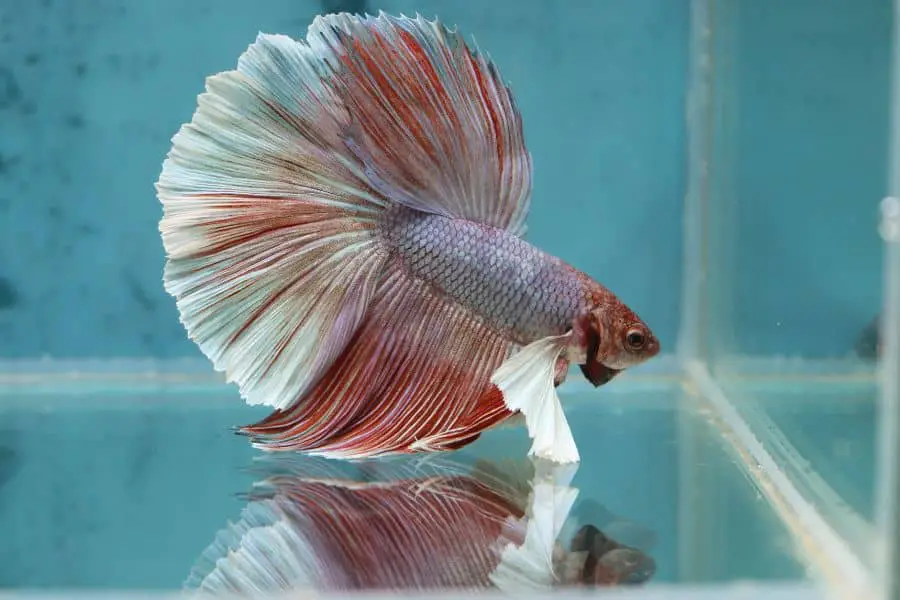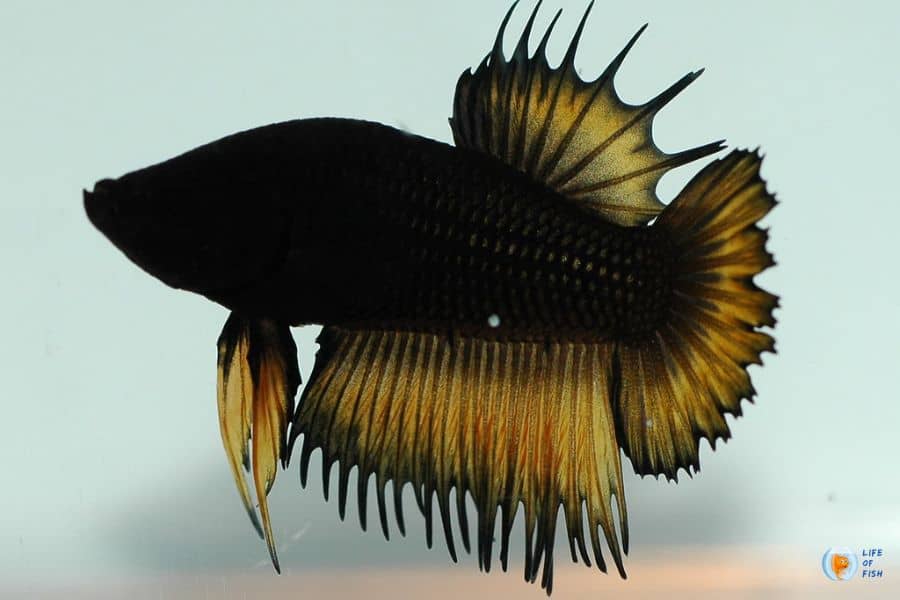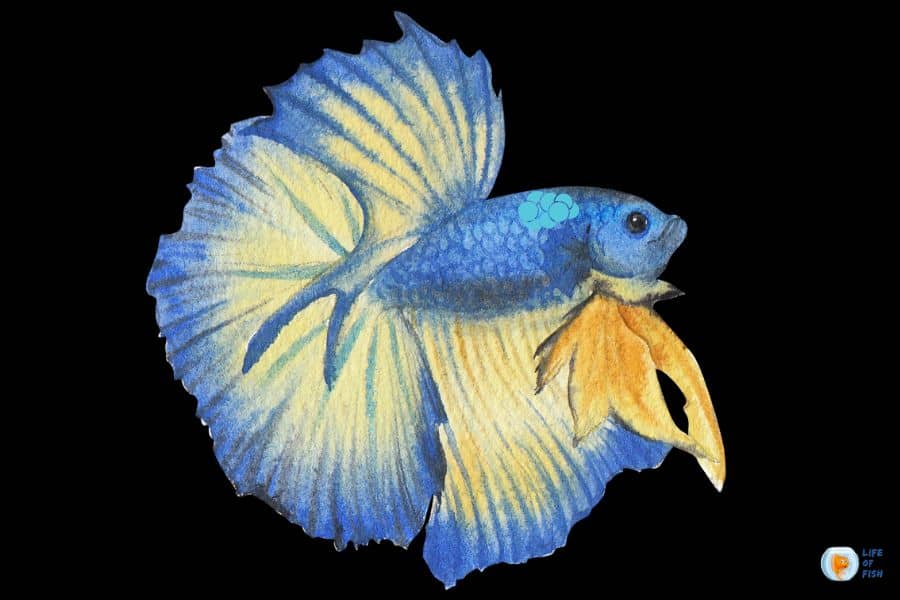Have you just fallen in love with Betta fish? Or are you a seasoned enthusiast? Whichever category you fall into, a fascination with these gorgeous water babies is totally understandable.
Apart from their undoubted beauty, they are fun, quirky and have their own unique personalities that will keep you gazing for hours as they flash through your aquarium, trailing clouds of brightly colored flowing fins.

As an aquarist, you would know that Betta are one of the most famous aquarium fish in the world. They are plentifully available, in a diverse variety of colors, fin shapes and sizes. You can buy betta fish for sale at your local pet shop, or have them shipped to you from online sellers.
Your water babies also come in a variety of prices, depending on whether they are rare betta fish or commonly available.
What makes them so popular as aquarium fish is their sheer beauty, and that they are not very difficult to care for.
Know More About Your Betta
Jump To
The name Betta today is synonymous with the Betta splendens species, though there are at least 72 other known species of this fish. They are also known as Siamese fighters or fighting fish. They are part of the Gourami family and are native to Thailand, Cambodia and Vietnam among others.
“Betta” is thought to come from a native word that means “Warrior.” All of them come from the Osphronemidae family. They were among the first fish that were domesticated in their native lands, nearly a millennium ago.
Its evolution is thought to have originated from a Gourami type ancestor that lived in shallow, murky water. This may have led to the development of the labyrinth organ that allows them to come up to the surface and breathe air from the atmosphere.
This is one of the unique traits that occurs only in some species of fish. The main reason for this evolution is that they have to survive in environments that contain less dissolved oxygen in the water.
They developed their colors to attract mates in this low light shallow water. The aggression is due to the need to protect their territory and make it a safe place to breed for young ones.
They are highly territorial and guard their space fiercely, sometimes even to their death. Whether it’s an intruder into their area or their own reflection in a glass, they will lunge into an attack. In the wild they are found in rice paddies and canals, where they are less aggressive due to the larger spaces available.

Take a look at the typical Betta:
- They are fresh water labyrinth fish, which means they can breathe air from the surface of the water
- Their bodies are torpedo shaped
- They can eat from the surface of the water as well as breathe from it
- Grow to about 3 inches in length
- Life-span about 5 years with proper feeding and care
- Brightly colored fins and tails of different types
- Twelve different tail types have been identified
- Commonly occur in red, blue, black, orange or white colors or iridescent colors
- Rare colors include purple, turquoise, metallic, copper
- They are natural carnivores and need a high protein diet
- Two males cannot be kept in the same tank as they may fight to kill
- Females form hierarchical groups, and pet parents must ensure that the group consists of odd numbers.
- Betta can live relatively peacefully with blue gourami, neon tetra, bottom dwelling fish and some species of frogs
Traits
In the wild, Betta are found in marshy areas, shallow water, flood-plains and wherever there is abundant vegetation.
In such places across South Asia, the hot weather causes quick evaporation of these wet lands, and that is one of the reasons why scientists opine that the Betta developed its characteristic “labyrinth”, a lung like organ that lets them breathe air directly, unlike other water creatures.
Their natural environment is subject to extreme and sudden tropical events such as rain, flood or dryness, and changes in the pH factor of water and soil chemistry, and that is why these fish can survive in relatively harsh environments.
The ideal temperature in an aquarium should be controlled between 26-28C. The ideal chemistry of water is pH 5.47, and the depth of water should be at least 2 inches. In the wild, there could be just 1.74 Betta per square meter, and the male-female ratio is slightly skewed towards females.
Their diet in the wild consists of insects, larvae and certain plant roots. They also eat small crustaceans, blood worms, brine shrimp and mosquito larvae.
Betta need luxuriant natural vegetation to hide while trapping their prey, for females to retreat while spawning and for males to mark out their territory.
Wild Betta usually spawn between the warm months of February and June. In captivity, Betta don’t have a specific breeding season, and they may lay eggs at any time of the year.
Females are generally docile and can live in small groups without any conflict. The male is highly aggressive towards other males, and also towards other species such as the Gourami. They are generally not aggressive towards creatures such as snails or slugs.

The male builds a protective bubble nest and places the eggs in the mouth as the female drops them. The male cares for the eggs and tends to them devotedly, adding more bubbles to the nest as the hatchlings grow.
They first became popular as pets in Western countries about two centuries ago when they were discovered by travelers and traders to South East Asia.
Today they are very common in captivity, but have become much rarer in the wild. In some countries such as Australia and sub-tropical regions of the United States, Brazil, Colombia, and Singapore they are a non-threatening invasive species, and there is no evidence that they pose a threat to natural eco-systems in these locations.
Betta are found plentifully in the shallows of the Chao Phraya river in Thailand and the Mekong River Delta in Vietnam. There has been no accurate census of their population.
Rare Betta fish: Genetic Characteristics
One reason why rare Betta are so expensive is because it takes a huge amount of time, effort and money to create them. There may be similar variations available at cheaper rates, but these are not the real thing!
Rare Betta are prized for their unique markings. This species is famous for its amazing morphological diversity. Most modern Betta have evolved from two main breeds, the Plakat Khmer and the Plakat Cheen.
Many of these have been artificially created by expert breeders who select the traits, features and colors they want. Rare species are very expensive and one of the unique Betta was sold for upwards of USD1000 in Thailand.
This amazing fish was marked with the colors of the Thai national flag, in a combination of red, white and blue, making it a conversation piece for the owner. Rare colors include deep green and purple, metallic hues, lavender, “Mustard Gas”, and intense orange.
In the Betta breeding community, rare species include those with an off-white color and a thick stripe at the gills, one with a half moon tail and a black beard, golden Betta, black and gold, and more.
The true purple, Samurai koi, Fantail, Dragon, Butterfly, Twin Tail, Crown Tail, Rose Tail and Dumbo are some of those prized by collectors and Betta enthusiasts the world over.
Interestingly, today, wild caught Betta are also considered to be rare. These were thought to be extinct in their original habitat, due to increasing urbanization, the use of chemical fertilizers, automation and the general decline of farming in native countries.
However, since 1981, wild Betta have been bred in captivity. They are very plain looking and super aggressive. These are also available at a steep price among collectors.
Apart from solid colors, Betta can be found with a variety of markings and patterns. Some have a solid color body with colored fins or vice versa. Banded colors, butterfly patterns, marbled, piebald, and more are the available betta fish for sale.
The other characteristic feature of Betta is their amazing finnage. Their fins have been bred to resemble crowns, wings, half-moons or suns, double tails and delta tails, elephant ears, spades and more.

The genetic characteristics of the Betta genome have been extensively studied. Scientists are interested in studying two aspects in the Betta, and these are their aggressive behavior and the pigmentation traits.
Betta were historically bred in ancient times for their aggressive traits, because there was a tradition of betting among punters using them. Historians opine that breeding of the Betta has been occurring for the last 600 years in Thailand.
This is similar to cock-fighting or dog-fighting betting. History reveals that even the King of Siam (the original name of Thailand) owned and maintained his own set of fighting Betta which were entered in competitions and tournaments, and proved to be a money spinner for the royal family!
This focus on aggression has become one of the dominant traits in Betta. As a result, many aquarium bred Betta are highly aggressive, sometimes even more than their wild cousins. Today, aquarium Betta are truly creations of selective breeding over the last 100 years at least.
One of the strangest looking Betta is the Cellophane Betta which is colorless and almost transparent in appearance. The red pigment has been bred out completely, and it has been bred for its white eyes and double tail.
This is just one example of how breeders can create a completely unique Betta by selecting the genotypes that they want.
Males generally begin to show aggression by the time they are about five months old and in commercial breeding facilities, they are kept isolated in smaller containers within the main breeding tanks. Females are usually kept in a communal environment.
Control and Selective Breeding
Breeders identify genetic characteristics based on dominant or recessive gene factors. This eliminates the uncertainty of not knowing what they will get when two different types are bred.
The dominant trait prevails even when there is a recessive gene and the only way to breed out the dominant trait is to ensure that there are two recessive genes in the genetic make-up.
Both dominant and recessive genes are passed down to the offspring, but the dominant gene will always appear unless there are two recessive genes.
There are certain dominant genes in Betta and they include coloration such as red. The color cells appear in four layers in all Betta and breeders have to identify the location of these cells.
In Betta, the layers appear in the order of blue, black, red, yellow. These hue layers have been mainly identified in the Betta body, though the fins and tails also contain them.
Apart from the genotype or genetic characteristics, there are phenotype (observable trait) factors that must be taken into account. Though genetic factors do play a major role in the final outcome, it is important to control other aspects as well to get the results you want.
Certain environmental factors have to be monitored, such as the temperature of the water, the quality of food and the pH balance and chemistry of the water.
When these conditions are kept at the optimal level, you can be pretty sure that the breeding results will be logical and exactly what you expect.
Conclusion
The rare Betta is a magical sight, and whether you’re a breeder or a pet parent, these exquisite creations will certainly give you hours of viewing pleasure. Knowing more about their genetic characteristics and traits helps you control breeding outcomes.
